New findings suggest that the early periods of the solar system were characterized by wandering planets and massive interplanetary destruction.
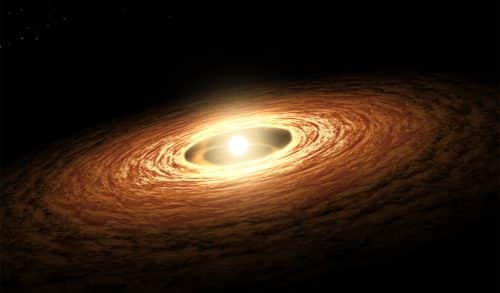
by Konstantin Batygin, Gregory Laplin, and Alessandro Morbidelli, The article is published with the approval of Scientific American Israel and the Ort Israel network 04.08.2016
- A wealth of new evidence, both from computer simulations and observations of planets across the galaxy, is revealing new details about the dynamic and tumultuous history of our solar system.
- The current configuration of the solar system, where small, rocky planets are found in the inner part while giant planets are found in the outer part, is unusual compared to most other solar systems observed so far, whose structure is different.
- The best explanation for the oddities of the solar system is that the giant planets went through a long series of orbital changes and dynamic instability billions of years ago.
- It is possible that during these upheavals entire planets were drawn into the Sun, while others were splashed into interstellar space. These events may have been of crucial importance for the appearance of life on Earth and the beginning of its development.
- And more: Does the ninth planet in the solar system, the existence of which was recently hypothesized, correspond to the most recent opinions regarding the formation of the solar system?
The story of the birth of our solar system has been told over and over again until it wears out over the years. It begins billions of years ago in a black cloud of gas and dust slowly rotating on its axis. The cloud collapses and a star forms in its center: our sun. Over time, eight planets and even smaller worlds like Pluto emerge from the remnants of gas and debris around the star. This system of sun and planets has been rotating in space ever since and its movements are as precise and predictable as clockwork.
In recent years, astronomers have noticed subtle clues that tend to disprove this familiar story. When you compare the structure of our solar system to the structures of thousands of other solar systems, you find that the most prominent features of ours - rocky worlds close to the sun, gas giants far from it and the absence of planets within Mercury (the planet Mercury) - are actually quite unusual. A look at our solar system's past through computer simulation shows that these anomalies are the result of a rather wild youth. The emerging rewrite of solar system history involves far more drama and chaos than anyone expected.
The new history is a story of wandering planets driven from their homelands, of lost worlds destroyed by the flames of the sun eons ago and of giant and lonely planets hurled into the frozen depths of interstellar space. By studying these ancient events and the scars they may have left, such as the recent hypothesis about Ninth planetPerhaps hidden in a distant orbit from that of Pluto, astronomers get both a capturing picture of the decisive and formative periods in the solar system and a new appreciation of its cosmic context.
The classical solar system
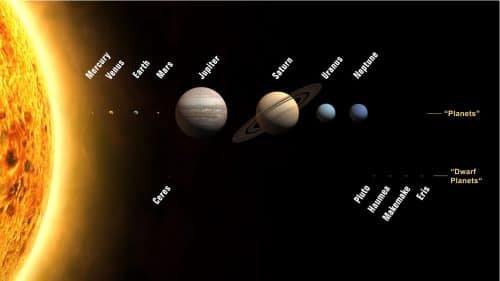
Planets are a byproduct of star formation. Such star formation takes place in the heart of huge clouds that are only 10,000 times greater than the mass of our sun and are made up of molecular materials. Congested areas in the cloud core can collapse inward and form pre-star A glow surrounded by a sealed ring of machine gas and dust Preplanetary disk.
For decades, theorists have searched in the ancient prestellar ring of our solar system for the explanation of one of its most distinct characteristics: the division into two types of planets, rocky and gaseous. Four solid worlds are found between the orbits of Mercury and Mars. These orbits are completed by these two planets in 88 and 687 Earth days respectively. In contrast, the gas-rich planets we know move in much more distant orbits, the completion of which takes 12 to 165 Earth years. They hold a mass 150 times greater than that of the solid planets.
Until now, scientists believed that the two types of planets originated from one and the same formation process in which dust grains swirling in the gaseous disk and the many eddies collided with each other and then stuck together to form objects several kilometers in diameter called Planetesimals. This process is similar to the process familiar to all of us where dust accumulations are created by air currents and electrostatic forces on a kitchen floor that has not been swept. The largest planetesimals also had the strongest gravity and soon grew larger by picking up bits of matter they encountered as they moved in their orbits. This process led to the fact that just one million years after forming from a cloud of gas, the protoplanetary disk of our solar system, like every disk of its kind in the universe, was full of moon-sized planetary embryos.
The largest embryo was beyond today's asteroid belt, far enough from the light and heat of the new sun that ice could exist in the preplanetary disk region around it. Beyond this "ice line", embryos of other planets could absorb more and more ice and reach enormous dimensions. As in the well-known observation that the rich get richer, so too the largest of the embryos was the one that grew the fastest, as its strong gravitational field rapidly drew in most of the available ice, gas and dust in its vicinity. In only about a million years, the starving embryo grew and became the planet Tzedek. And that was, the theorists believed, the decisive moment when the fragmented architecture of our solar system was created. The other large planets of our Sun are smaller than Zeddaq because they grew more slowly. When they reached the size where the gravity they exerted was already large enough, the amount of available gas was already considerably less because Tzedek had already absorbed most of the gas into it. The worlds born on the inner side of the ice line were even smaller because they grew in an area where the disk was relatively thin in gas and ice.
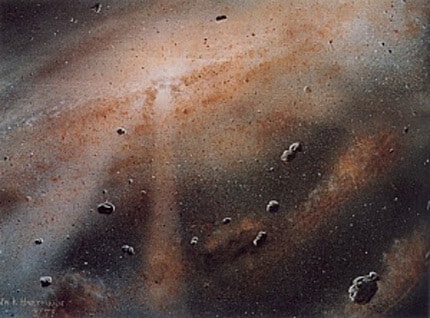
With the exception of a few pesky details, such as the very small masses of Mars and Mercury, this "just-first" model seems plausible as an explanation for the structure of the solar system. The expectation from other solar systems was therefore clear: the giant planets in them are expected to be found in orbits with a long orbital period beyond the ice line, while rocky worlds will be found in orbits of a few years or less. But this expectation, it turns out, was wrong.
Revolution outside the solar system
When astronomers began discovering planets outside our solar system more than 20 years ago, they also put the theory of the formation of the solar system to the test on a galactic scale. Many of the first planets discovered outside the solar system were hot Jupiter-like planets, which were called "hot Jupiters" (hot Jupiters): giant planets that are made of gas but orbit their suns in a cycle of only a few days. The existence of giant planets in such hot proximity to the star's surface, where there is no ice at all, completely contradicts the classical description of planet formation. In an attempt to reconcile the contradiction, the scientists concluded that these planets formed far from the Sun and then somehow migrated inward.
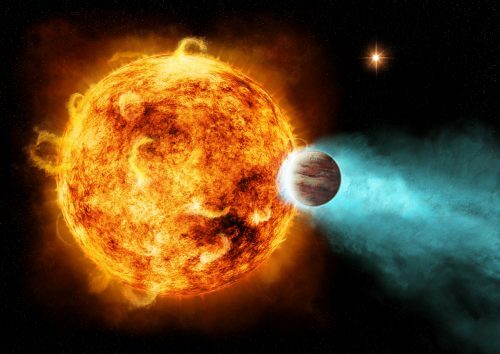
More than that, based on thousands of planets discovered outside the solar system in reviews like the one she conducted The Kepler spacecraft of NASA, the unpleasant truth that solar systems similar to ours are relatively rare is becoming increasingly apparent to scientists today. An average planetary system includes a superterrestrial planet (Super-Earth, a planet several times larger than Earth) one or maybe two, and they have an orbit shorter than 100 days. On the other hand, only about 10% of the suns have parallels to the giants Tzedek and Saturn and only a small part of those parallels move in approximately circular orbits.
When their predictions were wrong, the scientists realized that "some of the pesky details" in the classical theory about the formation of our solar system needed a better explanation. Why is the interior of our solar system so poor in mass compared to its counterparts in other systems, with only relatively dwarf rocky worlds and no extraterrestrial planets? Why doesn't it have planets in it from Mercury's 88 day orbit? And why are the orbits of the giant planets in our solar system so calm and far from the sun?
Based on thousands of exoplanets, the unpleasant truth is dawning on scientists today that solar systems similar to ours are relatively rare.
It turns out that answers to these questions may lie in the failure of the classical theory of planet formation to explain the variable and unstable nature of protoplanetary disks. It turns out that a new planet, like a lifeboat in the ocean, can drift away from its point of origin. Once a planet has reached a certain size, its gravitational influence spreads around it in the disk and generates spiral waves that exert their own gravitational forces. Thus, strong positive and negative feedbacks are created between the planets and the disk. At the same time, irreversible exchanges of momentum and energy can occur that allow young planets to embark on long journeys in their birth disk.
When the phenomenon of planetary migration is taken into account, it becomes clear that the ice lines in the disks no longer alone determine the architecture of the planetary system. For example, giant planets born beyond the ice line can become "hot Jupiters" if they drift inward, similar to gas and dust clumps that are pumped in a slug into the Sun.
The problem is that this process works almost too well and seems to be a very common feature among all preplanetary discs. If so, how can the distant orbits of Tzedek and Saturn be explained in our solar system?
The big reversal
The first sign of a convincing explanation came in 2001 from a computer simulation they did Frederic Masset וMark Snelgrove who were then at Queen Mary University in London. Masset and Snelgrove built a model of the simultaneous development of the orbits of Saturn and Tzedek in the preplanetary disk of our Sun. Because Saturn's mass is smaller, the rate of its inward migration is faster than that of Tzedek, and as the migration progresses, the two planets move closer together. In the end, their paths reach the so-called "coordination"Resonance of mean motion” and in it Tzedek circles the sun three times for every two cycles of Saturn.
Two planets whose movement is linked through such a resonance can transfer momentum and energy to each other as in an interplanetary passing game. Because of the special nature of the resonance disturbances, it is accepted that the two planets exert a common and increased gravitational influence on each other and on their environment. In the case of Tzedek and Saturn, this swing allowed them to slam their weight together in the preplanetary disk and level a large gap in it, Tzedek being more inner than Saturn. At this point, Tzedek, being the heavier planet, exerted a stronger gravitational pull on the inner part of the disc than Saturn exerted on the outer part. Counterintuitively, this caused the two planets to reverse their direction of travel and begin drifting away from the Sun. This movement of in and then out is often referred to as "The big reversal” on no account of the movement of a sailboat turning its prow to change direction against a steady wind.
In 2011, ten years after she first floated the idea of the big reversal, a computer simulation showed that Kevin J. Walsh, who was then working at the Cote d'Azur Observatory in the city of Nice in the south of France, and his colleagues, that he could explain well not only the dynamic history of Tzedek and Saturn but also the distribution of rocky and icy asteroids and the small mass of Mars. As Tzedek wandered in, his gravitational pull trapped planetesimals that came his way. He picked them up and pushed them forward like a snowplow. If we assume that Tzedek came as close to the Sun as Mars does today, it is possible that he carried with him into the rocky region of the solar system frozen building materials with a total mass of about ten times the mass of Earth and thus seeded this region with water and other volatile materials. This process also would have outlined a clear outer boundary for the distribution of material capable of creating planets in the inner region of the cloud and interrupted the growth of a nearby planetary embryo, an embryo that would later become the planet we call Mars.
Tzedek's great attack
Although the Great Reversal scenario seemed very convincing in 2011, the connection between it and the second great mystery of our solar system, the complete absence of planets inward from Mercury, was still unclear. Compared to other solar systems packed with extraterrestrial planets in orbits close to their sun, ours seems almost hollow. Why? It seems strange that our solar system did not participate in the common process of planet formation that we see elsewhere in the universe. In 2015 two of us (Batygin וLeflin) tried to think what the large reversal of direction would do to a group of extraterrestrial planets close to the Sun. Our surprising conclusion was that they would not have survived it. Amazingly, Tzedek's migration in and then out can explain many properties of the planets that are present in the system, as well as properties of those that are absent from it.
When Tzedek plunged into the interior of the solar system, the action of his snow plow on the planetesimals in his path would disrupt their orderly and circular orbits and turn them into a swarm of curled and intersecting paths. Some of the planetesimals would collide violently with each other and shatter into pieces that would end up colliding with each other and shattering into even smaller pieces. Therefore, Tzedek's inward migration apparently started a chain of collisions that depleted the planetesimal population and crushed them into rocks, stones and sand.
The great reversal of Tzedek and Saturn may have launched a major attack on a primordial population of extraterrestrial planets.
The planetesimals, broken and eroded by the crushing of the collisions and by the aerodynamic friction in the gaseous domain of the interior of the preplanetary disk, gradually lost their energy and spiraled down towards the Sun in an avalanche of decaying orbits. In napalm, they were easily trapped in additional gravitational resonances with ancient near-solar extraterrestrial planets.
This was not good news for these planets because these parasitic swarms of matter fragments fed off the energy of their orbital motion. The swarms, constantly slowed down by the gas flowing in the disk, were supposed to fall towards the sun. But thanks to their resonances with the extraterrestrial planets, they stayed put and absorbed the planets' orbital energy and then gradually released it as heat from aerodynamic friction. The result was that the crumbling planetesimal swarms pushed the planets into death spirals with brutal efficiency. The orbits of these planets got closer and closer to the sun until they fell into it. According to the simulations we made, none of those putative planets would have survived more than a few hundred thousand years from the beginning of the series of collisions.
Therefore, the great reversal of Tzedek and Saturn may have launched a major attack on a presumed primordial population of extraterrestrial and near-solar planets that existed in our system. If those ancient extraterrestrial planets had faded into the Sun like this, they would have left behind in the solar nebula an uninhabited space extending to an orbit of about 100 days. As a result, Tzedek's flyby through the young solar system created a relatively narrow ring of bits of rocky material, from which the rocky planets formed millions of years later. Due to the sequence of random events necessary for this delicate dance, small and rocky planets such as Earth - and possibly even the presence of life at all - are rare in the universe.
The Nice model
As Tzedek and Saturn made their way back from their trip into the interior of the solar system, the disk of gas and dust around them had already begun to thin out. The couple Tzedek and Saturn, who are related to each other by resonance, finally met the new Uranus and Neptune, and possibly also another celestial gram, similar in size to them. With the help of the gravitational effects of the dissipating gas, the dynamical pair also trapped the two smaller giants in its resonance. And so, while most of the gas in the disk disappeared, the structure of the interior of the solar system formed as a candle: a ring of rock fragments whose location was roughly where the Earth's orbit passes today. On the outskirts of the system, a dense chain of at least four giant planets, resonantly bound together, circled in near-circular orbits between today's Tzedek's orbit and midway between it and today's Neptune's orbit. Beyond the orbit of the most distant giant, the icy planetesimals of the outer part of the disk were spread out to the edge of the system. Over hundreds of millions of years, the rocky planets formed. The more distant worlds, with the wild past, calmed down and stabilized in a state that could have been stable for a long time. But fate had its way and this was not the last stage in the evolution of our solar system.
The Great Reversal and the Great Attack provided one last burst of interplanetary violence in the history of the Solar System: a finishing touch that brought the Sun's entourage of worlds into a configuration close to what we see today. This last burst is called "The late heavy bombardment". This is a period from 3.8 to 4.1 billion years ago when the solar system temporarily became a range full of barrages of planetesimals. We see the scars left from that period today in the giant craters that dot the Earth's moon.
The reactions between the major planets were so violent that one or more may have been ejected beyond the boundary of interstellar space.
In 2005, one of us produced (Morbidly) working with some colleagues at the Cote d'Azur Observatory in Nice model explaining how the interactions between the giant planets could have resulted in the late heavy bombardment. At the point where the big reversal ends, the Nice model begins.
Between the giant planets, close to each other, there was still resonance and they still felt a certain gravitational pull from the icy planetesimals at the edges of the system. However, the resonance between these planets was in an unstable equilibrium that any small change could upset. Cumulatively over millions of orbits over hundreds of millions of years, each planetesimal's pull - which alone is almost imperceptible - slightly shifted the motion of the major planets and chipped away at the delicate balance of resonance that binds them together. The turning point occurred when one of the giants went out of resonance with one of the others, which upset the balance and started a chaotic series of disturbances that pushed Tzedek slightly in and scattered the other giants out. In a short period of time on a cosmic scale, a few million years, the outer part of the solar system went through a shaky transition from a dense and almost circular state to an extensive and disordered configuration that has planets with wide and elliptical orbits. The interactions between the major planets were so violent that one or more may have been ejected into interstellar space.
If the dynamical evolution had stopped here, the structure of the outer part of the solar system would have corresponded well with the trends we see in giant planets in other systems, many of which circle in elliptical orbits around their suns. But fortunately, the icy planetesimal disk that started the Andalmusia also helped restore order in a series of interactions between the elliptical orbits of the giant planets. Most of the planetesimals that passed near the giant planets were thrown out, slowly reducing the orbital energy of these planets and re-centering their orbits. Although most of the planetesimals were ejected beyond the reach of the Sun's gravity, some of them remained in closed orbits and formed the icy debris disk that we call today Kuiper belt.
Ninth Planet, Last Theory
Patient observation work in the largest telescopes is gradually revealing the full extent of the Kuiper belt and slowly revealing an unexpected structure. Most notably, astronomers have noticed an unusual pattern among the most distant objects in this belt, which are right at the edge of observation from Earth. Although the distances of these objects from the Sun are different, their orbits are grouped together, as if they are all affected by a very strong common gravitational disturbance. Computer simulations done by Tigin andMichael A. Brown From the California Institute of Technology they showed that this state of affairs could be a natural result of a ninth planet that has not yet been observed, with a mass approximately ten times greater than that of the Earth and a coffee elliptical orbit around the Sun whose cycle time is approximately 20,000 years. It is unlikely that such a planet formed at such a great distance from the Sun, but it can certainly be classified as a globule ejected from a place closer to the center in the youth of the solar system.
If this hypothesis is confirmed, the existence of a ninth planet orbiting the Sun would considerably tighten the constraints by which we understand our strange and hollow solar system. This will set new limits to the theories that can be woven to explain all the unusual phenomena that exist in it.
Even now, astronomers are using some of the largest telescopes in the world to try to discover this hypothetical world. If discovered, it may mark the penultimate chapter in the long and complicated story of finding our place in the universe. It can only be followed by the summary that has not yet been written when we finally find life worlds orbiting other suns.
Like the strands of DNA whose sequence decoding reveals the stories of the ancient wanderings of the human race across our small planet, the astronomical clues allow our computer simulations to reconstruct the majestic saga of the wanderings of the planets during the billion-year life of our solar system. From its birth in swirling molecular clouds and the formation of the first planets to the growing pains from the world explosions of the Great Reversal, to the Great Attack and the Nice Model to the appearance of life and consciousness around at least one sun for the vast Milky Way. The complete biography of our solar system will be one of the most important achievements of modern science - and without a doubt one of the greatest stories that can ever be told.
Planet Nine from outer space
Does "Planet Nine", whose existence was recently hypothesized, correspond to the most recent views regarding the formation of the solar system?
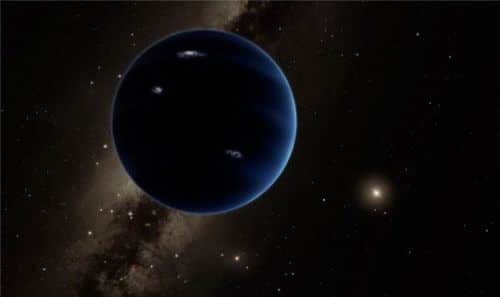
By Michael D. Lemonique
The idea that the solar system was so radically rearranged in the distant past could also explain the existence of the Kuiper belt andOrt cloud (a shell of icy objects found at the far fringes of the solar system) and also the ancient bombardments that the inner planets knew billions of years ago and what appears to be the absence of planets of the type known as super-Earths, or super-Earths, which are abundant in other solar systems. But now planetary scientists have another challenge to deal with: a putative planet, perhaps ten times the mass of Earth, orbiting in the dark regions beyond Pluto. If it exists, the gravity of that planet, known in the meantime as “Planet Nine”, could be the reason why the orbits around the Sun of several known objects in the Kuiper Belt are suspiciously similar.
But it is possible that its existence could provide another clue to the upheavals that the solar system knew in its early days. It must be assumed that this massive planet, whose minimum distance from the sun is estimated at about 30 billion kilometers, five times the average distance of Pluto from the sun, did not form there. There just wasn't enough material to build it. "If he is there," he says Harold P. Levinson, a theorist of planet formation at the Southwest Research Institute, "since it probably formed in the region between five and 20 [Earth's distances from the Sun] and was pushed out by [gravitational interaction with] Tzedek or with Saturn."
There is no dispute about this interaction. Tzedek, in particular, has such a large mass, he says Scott Tremaine, from the Institute for Advanced Research at Princeton University in New Jersey, who "doesn't care if he throws a comet or a planet ten times heavier than Earth." But an ejected planet would normally continue and eventually be ejected into interstellar space. The chance that it will instead go into orbit around the sun is extremely small. Statistically, Levinson says, the chance is one in 50 or 100, which he considers a low probability.
If the astronomers actually see the ninth planet in a telescope, the question of plausibility will be eliminated of course. Still, the question of how something so improbable happens is a question that theorists will have to consider. "My guess," Tremayne says, "is that the removal process is more efficient than the accepted model teaches" - that is, a higher proportion of objects that were flown out manage to stay in the system than everyone thinks.
The way it might happen, in the opinion of Ben Bromley from the University of Utah, is if the superterrestrial planet ejected very early in the life of the solar system, before the gas in the proplanetary disk that had clumped into planets dissipated. If that extraterrestrial planet ejected during this time, Bromley says, "it may have interacted with the gas and settled on the edge of the solar system."
Or maybe, says Nathan Cave, a theorist at the Carnegie Institution for Science in Washington, D.C., Planet Nine, if it exists, does not come from our solar system. The sun did not form alone but in a cluster of perhaps thousands of stars, each of which (probably) has its own planetary system. At least some of those systems must have gone through upheavals as well, spewing out objects like our sun is hypothesized to have done. "These objects," says Cave, "may have been captured by our sun."
The best explanation depends on what we find out about the orbit of Planet Nine; Those who hypothesized its existence calculated only a range of possibilities. If it does exist, scientists will probably be able to figure out how it got to where it is. The answer to the question of whether Planet Nine fits current ideas about the early solar system "is definitely maybe," Treiman says.
Michael D. Lamonique is an opinion editor at Scientific American
